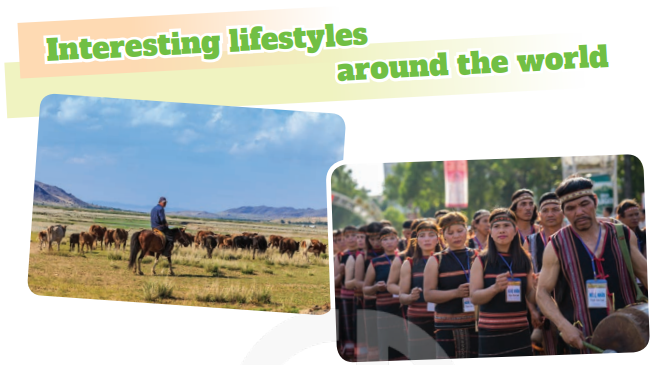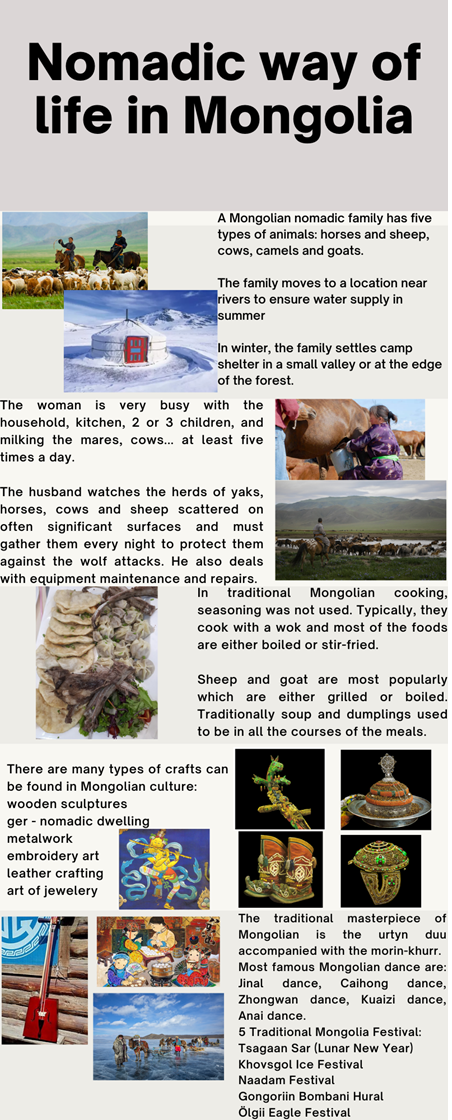Tiếng Anh 8 Unit 6 Project
1. Find information about an interesting way of life around the world, including: 2. Work in groups. Make a poster to introduce the people. 3. Give a presentation to the class.
Tổng hợp đề thi học kì 1 lớp 8 tất cả các môn - Kết nối tri thức
Toán - Văn - Anh - Khoa học tự nhiên
Bài 1
Video hướng dẫn giải

Work in groups.
(Làm việc theo nhóm.)
1. Find information about an interesting way of life around the world, including:
(Tìm thông tin về lối sống thú vị trên khắp thế giới.)
- everyday life (đời sống mỗi ngày)
- ways of cooking (cách thức nấu ăn)
- making crafts (làm đồ thủ công)
- folk songs and dances (múa hát dân gian)
- festivals (lễ hội)
You can refer to one of these, or you can choose your own. You may need to use the Internet to find information.
(Bạn có thể tham khảo một trong số này, hoặc bạn có thể chọn của riêng bạn. Bạn có thể cần sử dụng Internet để tìm thông tin.)
- Life of residents in Coober Pedy, Australia
(Cuộc sống của cư dân ở Coober Pedy, Australia)
- Nomadic life in Mongolia
(Cuộc sống du mục ở Mông Cổ)
- Life of the Ede ethnic group of Viet Nam
(Đời sống của dân tộc Ê Đê Việt Nam)
Lời giải chi tiết:
Everyday life: The life of Mongolian is punctuated by caring animals. A Mongolian nomadic family has five types of animals: horses and sheep for hot season and cows, camels and goats for cold season.
Several times during the year, according to the needs of livestock and pasture conditions, nomadic families move their yurts.
In summer, the nomadic family will favor a location near a river, to ensure water supply for the family and herds, and good pastures.
In winter, the priority is given to protection against the intense cold of Mongolian winter, and the family settles its "winter" camp sheltered from the wind in a small valley or at the edge of a forest.
The woman is very busy with the household, kitchen, 2 or 3 children, and milking the mares, cows... at least five times a day.
The husband watches the herds of yaks, horses, cows and sheep scattered on often significant surfaces and must gather them every night to protect them against the wolf attacks, frequent in Mongolia.
He also deals with equipment maintenance and repairs.
Ways of cooking: In traditional Mongolian cooking, seasoning was not used; although salt was there a long time and it is used it even in tea! Typically, they cook with a wok and most of the foods are either boiled or stir-fried.
Since a lot of livestock is raised in Mongolia, it is no mystery that Mongolian cuisine revolves around them. Sheep and goat are most popularly which are either grilled or boiled. Traditionally soup and dumplings used to be in all the courses of the meals, without which, it was regarded to be incomplete.
There are many types of crafts can be found in Mongolian culture: wooden sculptures, ger - nomadic dwelling, metalwork, embroidery art, leather crafting, art of jewelery.
The traditional masterpiece of Mongolian is the urtyn duu accompanied with the morin-khurr. Most famous Mongolian dance are: Jinai dance (milking dance), the Caihong dance (rainbow dance), the Zhongwan dance (bowl dance), the Kuaizi dance (chopsticks dance), and the Andai dance
There are lots of festival in Mongolia but these are the most well-known one: Tsagaan Sar (Lunar New Year); Khovsgol Ice Festival; Naadam Festival; Gongoriin Bombani Hural; Ölgii Eagle Festival.
Tạm dịch:
Cuộc sống của gia đình người Mông Cổ thì phụ thuộc vào sức khỏe của đàn gia súc và được nhấn mạnh bằng việc chăm sóc chúng. Một gia đình người Mông Cổ có năm loài động vật là ngựa, cừu, bò Tây Tạng, lạc đà và dê. Theo sự cần thiết về gia súc và chỗ chăn thả, các gia đình du mục di chuyển chỗ ở của mình. Vào mùa hạ, các gia đình du mục sẽ thích những nơi ở gần sông, để đảm bảo nguồn nước cho gia đình và đàn gia súc và có chỗ chăn thả tốt.
Vào mùa đông, mục đích chủ yếu là bảo vệ khỏi cái giá lạnh của mùa đông Mông Cổ, người ta sẽ xây chỗ trú đông tránh gió trong một ngọn đồi nhỏ hay bìa rừng. Người vợ rất bận bịu với công việc nhà, bếp núc, con cái và vắt sữa ngựa, bò… ít nhất 5 lần một ngày. Người chồng thì chịu trách nhiệm trông coi đàn bò, ngựa, cừu, rải rác trên một khu rộng lớn, và phải gom chúng lại vào mỗi đêm để bảo vệ chúng khỏi sự tấn công của chó sói, điều thường thấy ở Mông Cổ. Ông ấy cũng giải quyết việc giữ gìn và sửa chữa dụng cụ.
Người Mông Cổ không dùng gia vị khi nấu ăn; dù là muối đã xuất hiện từ rất lâu và nó còn được dùng với trà. Thường thì họ sẽ nấu trong một cái chảo lớn và hầu hết đồ ăn là luộc hoặc xào. Phổ biến nhất là thịt dê và thịt cừu được nướng hoặc luộc. món súp truyền thống và súp được dùng ở trong tất cả các bữa ăn.
Có rất nhiều loại đồ thủ công có thể tìm thấy trong văn hóa của người Mông Cổ như là: chạm khắc gỗ, làm ger, kỹ nghệ sắt, đồ thêu, làm đồ da, làm trang sức.
Kiệt tác truyền thống của người Mông Cổ chính là bài hát có tên là urtyn duu được đệm bằng đàn morin-kurr, Các điệu múa truyền thống của người Mông Cổ gồm: điệu Jinal (múa vắt sữa), điệu Caihong (múa cầu vồng), điệu Zhongwan (múa tô), điệu Kuaizi (múa đũa), và điệu Andai). Có rất nhiều ngày lễ ở Mông Cổ nhưng những lễ này là phổ biến nhất như Tsagaan Sar (Tết Nguyên Đán), Lễ hội băng ở hồ Khovsgol, Lễ Na-đam, Gongoriin Bombani Hural (Hội Đua ngựa), Lễ hội Đại bàng Vàng.
Bài 2
Video hướng dẫn giải
2. Work in groups. Make a poster to introduce the people.
(Làm việc nhóm. Làm poster giới thiệu nhóm người.)
Lời giải chi tiết:

Bài 3
Video hướng dẫn giải
3. Give a presentation to the class.
(Thuyết trình trước lớp.)
Lời giải chi tiết:
Hello everyone, today our group will introduce the nomadic way of life in Mongolia. The life of Mongolian family depends on the healths of herds and is punctuated by caring for animals.
Traditionally, a Mongolian nomadic family has five types of animals: horses and sheep, cows / yaks, camels and goats.
Several times during the year, according to the needs of livestock and pasture conditions, nomadic families move their yurts.
In summer, the nomadic family will favor a location near a river, to ensure water supply for the family and herds, and good pastures.
In winter, the priority is given to protection against the intense cold of Mongolian winter, and the family settles its "winter" camp sheltered from the wind in a small valley or at the edge of a forest.
The woman is very busy with the household, kitchen, 2 or 3 children, and milking the mares, cows... at least five times a day.
The processing of dairy products (cream, yogurt, liquor, milk, cheese ...) takes a long time as well.
The husband watches the herds of yaks, horses, cows and sheep scattered on often significant surfaces and must gather them every night to protect them against the wolf attacks, frequent in Mongolia. He also deals with equipment maintenance and repairs.
In traditional Mongolian cooking, seasoning was not used; although salt was there a long time and it is used it even in tea! Typically, they cook with a wok and most of the foods are either boiled or stir-fried. Sheep and goat are most popularly which are either grilled or boiled. Traditionally soup and dumplings used to be in all the courses of the meals.
There are many types of crafts can be found in Mongolian culture: wooden sculptures, ger - nomadic dwelling, metalwork, embroidery art, leather crafting, art of jewelery.
The traditional masterpiece of Mongolian is the urtyn duu accompanied with the morin-khurr. Most famous Mongolian dance are: Jinai dance (milking dance), the Caihong dance (rainbow dance), the Zhongwan dance (bowl dance), the Kuaizi dance (chopsticks dance), and the Andai dance
There are lots of festival in Mongolia but these are the most well-known one: Tsagaan Sar (Lunar New Year); Khovsgol Ice Festival; Naadam Festival; Gongoriin Bombani Hural; Ölgii Eagle Festival. Thanks for listening.
Tạm dịch:
Xin chào mọi người, hôm nay nhóm tụi mình sẽ thuyết trình về lối sống du mục của người Mông Cổ. Cuộc sống của gia đình người Mông Cổ thì phụ thuộc vào sức khỏe của đàn gia súc và được nhấn mạnh bằng việc chăm sóc chúng. Một gia đình người Mông Cổ có năm loài động vật là ngựa, cừu, bò Tây Tạng, lạc đà và dê. Theo sự cần thiết về gia súc và chỗ chăn thả, các gia đình du mục di chuyển chỗ ở của mình. Vào mùa hạ, các gia đình du mục sẽ thích những nơi ở gần sông, để đảm bảo nguồn nước cho gia đình và đàn gia súc và có chỗ chăn thả tốt.
Vào mùa đông, mục đích chủ yếu là bảo vệ khỏi cái giá lạnh của mùa đông Mông Cổ, người ta sẽ xây chỗ trú đông tránh gió trong một ngọn đồi nhỏ hay bìa rừng. Người vợ rất bận bịu với công việc nhà, bếp núc, con cái và vắt sữa ngựa, bò… ít nhất 5 lần một ngày. Người chồng thì chịu trách nhiệm trông coi đàn bò, ngựa, cừu, rải rác trên một khu rộng lớn, và phải gom chúng lại vào mỗi đêm để bảo vệ chúng khỏi sự tấn công của chó sói, điều thường thấy ở Mông Cổ. Ông ấy cũng giải quyết việc giữ gìn và sửa chữa dụng cụ.
Người Mông Cổ không dùng gia vị khi nấu ăn; dù là muối đã xuất hiện từ rất lâu và nó còn được dùng với trà. Thường thì họ sẽ nấu trong một cái chảo lớn và hầu hết đồ ăn là luộc hoặc xào. Phổ biến nhất là thịt dê và thịt cừu được nướng hoặc luộc. món súp truyền thống và súp được dùng ở trong tất cả các bữa ăn.
Có rất nhiều loại đồ thủ công có thể tìm thấy trong văn hóa của người Mông Cổ như là: chạm khắc gỗ, làm ger, kỹ nghệ sắt, đồ thêu, làm đồ da, làm trang sức.
Kiệt tác truyền thống của người Mông Cổ chính là bài hát có tên là urtyn duu được đệm bằng đàn morin-kurr, Các điệu múa truyền thống của người Mông Cổ gồm: điệu Jinal (múa vắt sữa), điệu Caihong (múa cầu vồng), điệu Zhongwan (múa tô), điệu Kuaizi (múa đũa), và điệu Andai). Có rất nhiều ngày lễ ở Mông Cổ nhưng những lễ này là phổ biến nhất như Tsagaan Sar (Tết Nguyên Đán), Lễ hội băng ở hồ Khovsgol, Lễ Na-đam, Gongoriin Bombani Hural (Hội Đua ngựa), Lễ hội Đại bàng Vàng. Cám ơn mọi người đã lắng nghe.
- Tiếng Anh 8 Unit 6 Looking back
- Tiếng Anh 8 Unit 6 Skills 2
- Tiếng Anh 8 Unit 6 Skills 1
- Tiếng Anh 8 Unit 6 Communication
- Tiếng Anh 8 Unit 6 A Closer Look 2
>> Xem thêm
Luyện Bài Tập Trắc nghiệm Tiếng Anh 8 - Global Success - Xem ngay












